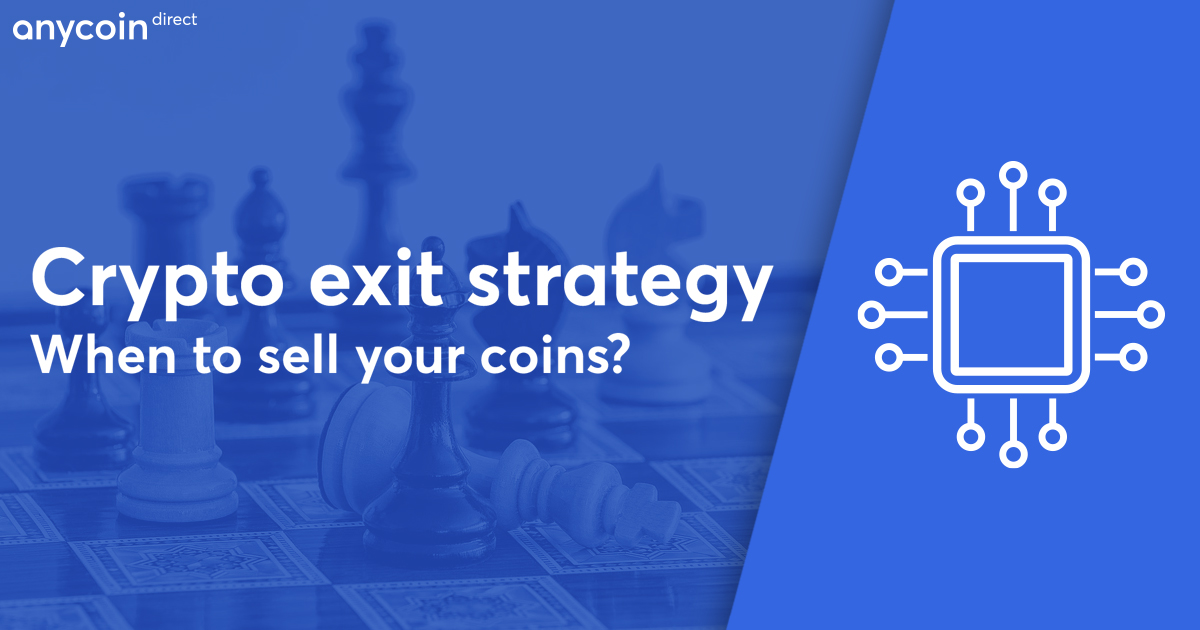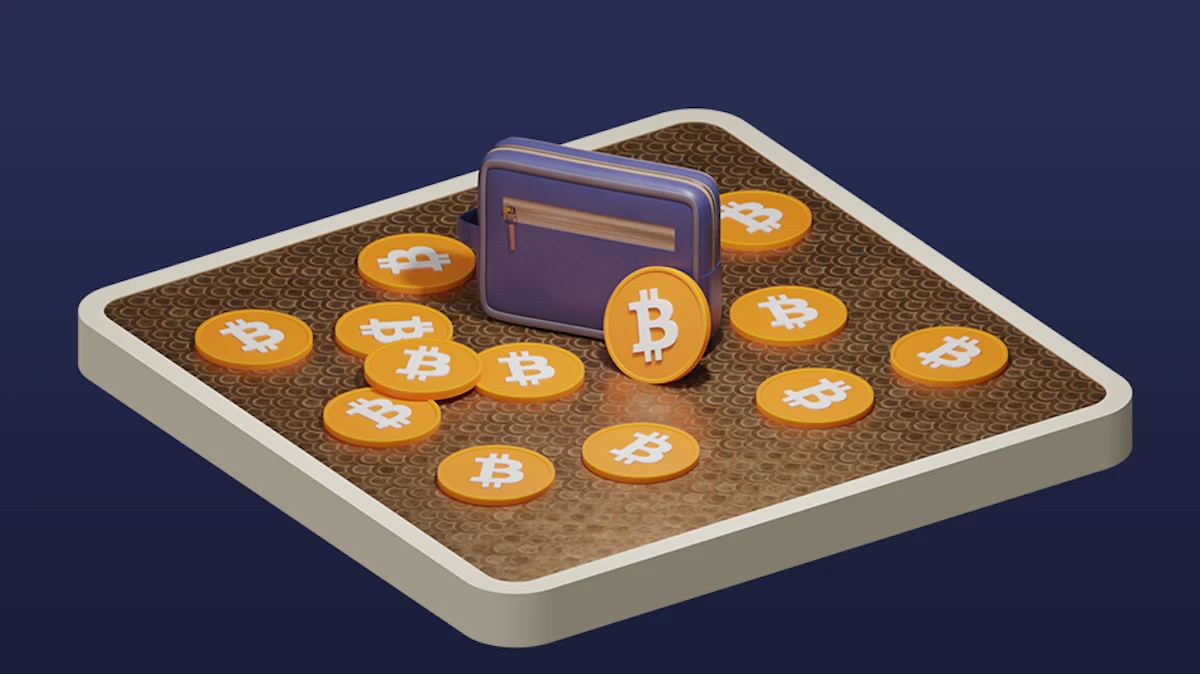Crypto exit strategy – When to sell your coins
- 5 minute read

Many new investors have no plan when it comes to selling or monetizing their purchased crypto currencies. If you are new to trading cryptocurrencies or stocks, this might be the first time you ask yourself: 'Do I hold or sell my cryptocurrencies?', or ''What is the best time to sell?". These questions can be difficult to answer even for experts. In this article, we explain what the most common mistakes are, how to avoid them, and tell you about the most used crypto exit strategies.

How to create an exit plan for your cryptocurrency holdings
- What is a crypto exit strategy?
- Why you need an exit strategy
- Limit/Stop orders
- Price targets
- The Step-by-Step-Method (Dollar-Cost-Averaging-Out)
- Initial Investment Return
- HODL'ing
- Cyclus
- Staking
- Portfolio management
- Stablecoins - Create passive income with your crypto
- The purpose of your investments
- Conclusion
What is a crypto exit strategy?
Technically, an exit strategy is a plan made with the intention of liquidating a position in a financial stock. Or simply put: A plan to sell your financial holdings. The purpose of an exit strategy is to limit losses in case of a collapse or take profits.
So basically, before you buy, you should already have a clear plan for selling. Otherwise, you risk sinking into the cryptocurrency quagmire without a foothold. One of the biggest pitfalls with an exit strategy is keeping it flexible. In that case, you don't actually have a strategy at all, and you may miss all the exit opportunities. With that explained, we discuss the most used exit strategies.

Why you need an exit strategy
Holding (or HODL'ing) a particular currency for too long, for instance due to greed, can result in huge losses even if the price used to be well above the entry price. Let me give you an example. If you decided to buy a cryptocurrency in January and prices happen to jump by 20%, you might think that selling is the way to go. However, all your friends decided to hold the coin. That means you would be the only one missing out on higher profits if the coin decides to moon (as crypto fanatics would call it). This phenomenon is also known as The-Fear-of-Missing-Out (FOMO), a mistake many investors make while trading. After looking at your portfolio with satisfaction, you decide to hold the coin for another 2 months. Within those 2 months, the price of your investment has turned south, suffering a massive 50% drop. That means your investment is now worth less than it originally was.
What now? Do you sell and take the loss? Or do you hold on and wait for a price recovery? Who knows, the currency may never return to its all-time-high. Many inexperienced traders sell at such a time in a panic at a hefty loss. As you can see, choices like these could have been avoided if you had an exit strategy in the first place. If you decided to sell your crypto coins when the price rose by 20%, you would have made significant profits. This is why you really need to think about a solid exit strategy. Below are the top of most used exit strategies in cryptocurrency.
Limit/Stop orders
One of the most well-known ways to limit a loss, or take profit at a certain price range, is called 'Limit orders'. What this means is that you can decide ahead of time that your shares or crypto will automatically be sold or bought at a certain price point. For example, you bought €100 worth of Bitcoin at a price of €25,000 and you want to sell that Bitcoin as soon as the price reaches €20,000 to limit your losses. One way to do this would be to set a limit order (to sell) at the price of €20,000. That means, as soon as the price hits that specific price target, an order to sell the asset at that specific price is added to the transaction book. The order remains open until the price limit is hit, or until you decide to cancel the order.
The convenience of limit orders is that they are automatically executed even when you are asleep. Setting limit/stop orders can be a way to limit losses or take profits. However, you should bear in mind that in case of extreme price fluctuations, the order might not be filled in time! Nevertheless, it is always a good idea to place limit/stop orders. To make things even easier, you can also set an OCO order on most exchanges. This means a One Cancels the Other order. It is a combination of a stop loss and a take profit order. With this, you set, for example, that you sell Bitcoin when it hits €20,000, but also when it hits €30,000. If one condition happens, the other expires. This way, you can be sure to take profits and possibly your losses.
Price targets
Before you set price targets, it is also important to set your overall goals before you get into cryptocurrencies. Think about what you want to achieve with your investment and whether you want to invest for the long or short term. Knowing why you are investing makes making decisions a lot faster and easier.
Next, you will determine at what price targets you will sell your cryptos. After all, having targets protects you from big losses. Let's take Bitcoin as an example.
If you have invested in Bitcoin and you believe it can become worth 100,000 euros, it is still smart to set earlier price targets. Depending on your targets, you can already sell a portion at 80,000 and 90,000 euros. This will ensure you make a nice profit. Should the price suddenly drop sharply, you have already put away a nice amount to buy in again.
The Step-by-Step-Method (Dollar-Cost-Averaging-Out)
Always make sure you have a plan before you invest in something. You need to think about when you will be satisfied with the result. Will a 20% price increase make you happy? Or are you someone who wants at least a 200% profit before selling? This is where the Step-by-Step Method comes in. This method is also known as Dollar Cost Averaging (Out). Dollar-Cost Averaging (DCA) is usually used as an investment tactic where you spread your budget and buy periodically at a fixed time. This way, you don't have to deal with the volatile nature of cryptocurrency. After all, you buy or sell at fixed points/times.
For instance, you can invest a certain amount from your salary every month, buying both high and low. As a result, you will see that you end up buying on average, which is why this method is called that. The Step-by-Step Method allows you to sell a predetermined percentage of your assets at certain price points. There is no golden rule that will lead to definitive success. However, this strategy can prevent you from getting too greedy or selling too late, while still taking profits from time to time. Many investors will always hold 5-10% of their holdings for a longer period, for when a bigger uptrend occurs or because they firmly believe in the project they invested in. Those who want to go deep into this might want to read a book by Warren Buffett on how he buys stocks.
It is always smart to take profits at a certain price range. This tactic seems a bit simplistic, but it will often lead to better results in the end rather than trying to time the market or your sell orders. An example of the step-by-step method can be found below.
| Selling Point | Percentage to be sold% |
|---|---|
| $25,700 | 10% |
| $35,700 | 10% |
| $49,700 | 20% |
| $79,700 | 20% |
| $104,700 | 20% |
| $155,300 | 10% |
Return on initial investment
Another smart thing investors do is to take profits in proportion to the amount invested. For example, if you have invested €1000, taking profits up to an equal amount at a later date can be a great way to liquidate the risk of losing money. This way, you ensure that whatever happens, you can never lose more money than you initially invested. You only play on with your winnings.
HODL
HODL is short for Hold On for Dear Life. The f is only omitted so it can still be pronounced. The term comes from a legendary post by someone who wanted to spell HOLD, but had too much to drink to keep his typing skills up to par.

This is basically a strategy with no exit. Of course, people will eventually want to sell, but they hold a cryptocurrency for a very long time. Say you buy into Bitcoin now and think the coin will be worth a lot more in 10 years. You just wait for those ten years to pass and then see where you stand.
This is a very relaxed form of investing, as you can imagine. One cycle after another follows, but you hardly watch. You sit on your investment until hell freezes over. After the period that you wanted to HODL is over, you start looking at what your investment is worth now. At that point, you only start looking at when is a smart time to sell, for example in the bull market after Bitcoin halves.
This may not be the most effective strategy, but your sleep will definitely not be disturbed! Really something for Zen Buddhists. At least, if these would care about money.
Cycles
Like traditional financial markets and the stock market, the crypto market also has cycles. A cycle consists of two phases, called the bull market and the bear market. In the bull market, the value of most cryptocurrencies rises exponentially. Price increases of thousands of percent in a few months are not unthinkable.
In the bear market the opposite happens, and prices of most cryptocurrencies drop hard. These price drops, also known as corrections, can lead to a depreciation of more than 99% in some cases. You can check this at CoinGecko by looking at the difference from the All Time High. In a bear market, you will see numbers there of -95% or more. So, if you look at it positively, you can buy in at a very low price and make a lot of profit. The bear market is therefore the best time to buy coins. Determining the start or end of a cycle is difficult. Usually, one only finds out along the way that a new cycle has already started. Although many picks are based on previous cycles, it can never be guaranteed that the current cycle is in sync with the previous one.
The current cycle is quite different from the previous cycle four years ago (crypto cycles tend to last around 4 years). This time around, cryptocurrencies are more accessible than ever. There are dozens of brokers and exchanges with mobile applications that make transactions and trading quick and easy. The growing popularity of crypto has not gone unnoticed in the corporate world either. Every week, new institutional organizations are investing in one or more cryptocurrencies. When you invest based on the cycle strategy, you take the many corrections associated with a bull market at face value. You know the market is very volatile and therefore don't shy away from small and large dips. Still, this strategy is very risky because the end of a bull market cannot be predicted. You can try to time it, but this exit strategy is only recommended if you are a cool frog. So, use this strategy mainly as a tool and not as THE exit strategy.
An aid here is not to want the bottom line. It is fine if you buy a coin 10% too high and sell it 10% too low. That is still a substantial difference over the course of a cycle. Nothing is more annoying than having missed the bottom completely and not being able to buy in or having just missed your top target and you're stuck with coins that are becoming worth less and less.
Staking
Staking seems at first glance to be a very safe way to get extra coins. However, it has good and less good features. Fortunately, you can use the good properties yourself and bypass the lesser ones. If you buy a coin that you can stake, you get free interest on your coins. It's not completely free either, as you must stake them more often. Usually, you stake coins on an exchange. Staking is done on proof of stake networks. Validators create new blocks on a blockchain and thus secure the network. For this, they get extra coins as a reward. You can become such a validator yourself, but often it is too expensive, or you don't get the chance because they have high requirements. You can then delegate your coins to a validator and get part of the reward. This is how it often works on exchanges, where the exchange is the validator, and you can stake your coins and get interest.
It is best to buy proof of stake coins the moment such a coin is low in the bear market. From then on, you start getting interest and the more coins you have bought in, the more interest you get. The buying moment determines how much profit you can make. The best moment is therefore around the bottom of a bear market. This is when the coin is quite low, and you get relatively many coins. As time goes on, you get more and more coins, because you also get interest on interest if you reinvest everything.
The nice thing about staking on an exchange is that you can usually claim your coins immediately if you want them back. With staking, the same rule applies: the longer you must hold coins, the more risk you run. If you stake coins, keep a close eye on the market. As soon as the price approaches your target, unstake the coins and create a sell order or an OCO order, so that you actually take the profits. An important detail to watch out for is how much interest you get and whether that doesn't affect the price too much. Normal ranges are 0-10%, but if it is more, the price may just drop. You will have to determine the buying and selling price based on past cycles. It is best to buy older proof of stake coins, so you can also determine reasonably well what is a good buying price and when it is time to sell. You should also pay attention to how many coins are added each year. If, according to the roadmap, a lot of coins are suddenly put on the market, you can imagine what that will do to the price. Those kinds of nasty surprises occur regularly with newer coins, for instance if many coins were locked to a certain period and suddenly become free to sell by early investors or the team behind the coin. Staking can therefore yield a lot of extra profit if you do the buying and selling at the right times. So, you get more coins that also become worth more, if you have a good exit strategy.
Portfolio management
A big mistake many people make is that they only invest in 1 project. Of course, this is not a disaster if the project you have invested in skyrockets. If the coin collapses or even disappears, you will have little to nothing left. By betting on multiple horses, you can get better results in the future. This is why it is important to think about which projects you want to hold for the long term. In portfolio management, you can think of a subdivision that is common: Bitcoin and Ethereum, large caps, small caps and unknown coins that are still low but have potential. These are listed in proportion to risk. A good way to address this is if you invest most of your money in coins that are also likely to be around tomorrow. Nothing is certain in cryptocurrency, but surely Bitcoin and Ethereum will still be around tomorrow? Beware of investing too large a portion in coins that are low ranked. With that, you can let other gains evaporate.
Some projects come in with a lot of bells and whistles and explode in price. Then, of course if you bought them, they stay around that same price indefinitely or drop little by little. This is a big risk and could be a good reason to protect your money and sell. So sometimes you should sell (part of) your crypto and reinvest it in coins that you estimate will give you better returns. The lower a coin ranks in CoinGecko, the higher the risk of investing. Coins that have been around longer are also less likely to explode or collapse to lower spots. When they start sinking, you can still sell them. This will happen much slower with established coins than with a coin that is new and losing popularity. Coins that have been around for more than eight years are established coins, which have already experienced two bull markets and are therefore more predictable than younger coins.
You can check this in CoinGecko. You look at a coin's chart and set it to max to see what its bottom was and its top in the bear and bull market. That doesn't mean it will go like this again, but this way you have guideposts for buying and selling. For example, if you think XRP (Ripple) is the future for global payments, you might want to back this project for a long time. If you just bought XRP because you expect it to rise in the short term, we would recommend selling this kind of project via the Step-by-Step Method. But now what? You have successfully closed your trades and made significant profits. Many investors will then reinvest their profits in new projects to make even more significant profits. Remember, it is always better to take profits before it is too late. Especially in the cryptocurrency market, price fluctuations are very common, and they can be quite extreme. You can trust us when we say this. We have experienced it before. Taking profits from time to time is a sensible approach.
Another option is to set a price target for your entire portfolio. For instance, you can decide in advance that you will sell everything the moment you have gathered 3x your deposit. This way, you do not focus on individual coins, but determine your crypto exit strategy based on your overall success. As soon as the bear market starts, you will have to sell all your coins and exchange them for euro or stablecoins. Optionally, you can then stake those into stablecoins, so your money doesn't just sit there for a year or more.
Stablecoins - Create passive income with your crypto
This is especially a strategy after you have already taken profits. After all, you can go on holiday with your well-earned crypto profits, but you can also invest it further so that your profits only grow further. After all, during a bear market, it is not interesting to invest further in crypto, as the values mainly drop. A great alternative to still stay in the crypto market is to convert your profits into stablecoins, so you get interest on them every year.

Getting interest from the bank because you have money in there is out of date. Depending on the size of your savings, you must even pay taxes on them. Fortunately, there are several platforms nowadays where you can get a nice return with stablecoins. You don't have to worry that your deposit will become worth less money, because stablecoins are value stable cryptocurrencies. So, they do not decrease or increase in value. Depending on the amount you invest and the period you commit to the investment, the interest is determined. Normally, it works like this: the longer you stake them, the higher the interest rate.
However, you will have to ask yourself whether a certain interest rate is sustainable. For instance, an interest rate of 1-5% is still sustainable for a platform, but if it is higher, you will have to ask yourself where they will get that interest from. If a platform may not or cannot print stablecoins itself, other people will probably have to pay your interest. That is starting to look like a Ponzi scheme. Quite a few platforms collapsed in the world of DeFi because they could no longer give the interest rates. A platform gets income from transactions and from lending out assets (by others). Is that enough to pay the interest on stablecoins? A trip to the Icesave drama does say enough. What you also need to consider is how long your investment is tied up in a stake contract. Every day you must hold a position is a day you are at risk. If the platform goes down, you lose everything. It might be a good idea to keep your greed in check and be satisfied with 2-3% on a strong exchange, where you can get your money back every day.
The purpose of your investments
It is always useful and advisable to work with goals as well. For example, you can have a goal of being able to pay for your children's studies and when you have achieved this you skim this portion, keeping it safe. Goals come in all shapes and sizes. Some want to become millionaires, others want to pay off their house and others want to buy a new car or go on holiday. Fine, all of them. However, if you have no goal in mind, then it seems more like a math than a goal game. And without a goal, you are swimming in a pool with no edges.
Conclusion
Before investing, we strongly recommend doing your own research on a project! The cryptocurrency market can be very volatile and can lead to financial losses. However, the reverse is also true. With safe investment strategies like the ones mentioned above, you minimize the risk of losing your investment. In short, we recommend that you use limit/stop orders, follow the Step-by-Step Method, take profits, and possibly reinvest your profits in new projects or stablecoins.
Just one more thing: never invest money that you may need later for rent or something. By the time you need the money again, your investments may have temporarily become worth much less and you will have to sell because the rent must be paid anyway. Only invest money you can afford to lose.
The strategies listed above are for educational purposes only. Anycoin Direct never gives financial advice. You should always do your own research before investing!


